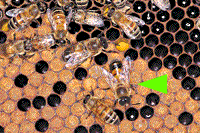 |
| Bee Square HOME | The Miraculous Life of Bees | A Surprising Story about Bees | Look into a honeycomb! | An Introduction to Beekeeping |
| Honeybee Restaurant | Beekeeping Reports from Around the World | Fairy Tales and Picture Books about Bees Story Collection | News From the Bee Farm | Links |
|
|
|
 Takayuki Ono Yamada Bee Farm, Beekeeping Division |
|

When the new worker bees hatch, royal jelly secretion and egg-laying increases. As the young worker bees get older day by day and are about ready to go out foraging, the changing of the generations takes place. The worker bees that lived through the winter rapidly die off. In early April we move the hives from the warm area to a clover field. We consider the placement of the hives to achieve the right balance between the area of flowering clover and the number of honeybee colonies.
Cherry blossoms, by the way, do not have much nectar that can be collected, but they do provide a lot of pollen. During cherry blossom viewing season, everyone's attention is usually drawn to the vivid blossoms, but listen closely at the foot of a tree and you'll hear the buzzing sound of the worker bees. They are having a spring feast. The honeybees are joined by bumblebees, too, enjoying the bounty of springtime. In the middle of April, immediately after the clover starts to flower we have the first honey extraction of the year. This honey contains a mixture of nectar from the previous year that was food for the bees over the winter and honey from a variety of early spring flowers, so this removal is also done to clean the hive. By performing this first honey removal we are later able to get pure, unadulterated clover honey.  Also, the more honey is stored in the hive, the less active honeybees become. When we remove the honey and the stores suddenly disappear, the bees will again work energetically. In Kagamino, clover honey can be obtained from late April to early May. Also, the more honey is stored in the hive, the less active honeybees become. When we remove the honey and the stores suddenly disappear, the bees will again work energetically. In Kagamino, clover honey can be obtained from late April to early May.This is the most exciting season of the year for obtaining honey. Just as the honeybees become active, our work also gets busy at this time of year. |
||

Yamada Bee Farm (Kagaminocho Pref. Okayama)
Copyright(C)2005 Yamada Bee Farm All Rights Reserved.
|

